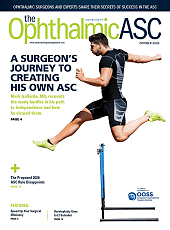When a patient of ophthalmologist Grayson W. Armstrong, MD, MPH, asked if cataract surgery could make his age-related macular degeneration (AMD) worse, he couldn’t provide a definitive answer, not because researchers have never asked this unsettling question, but because the available data are in conflict. Some early population-based research has suggested an increased risk of AMD worsening after surgery, including a higher likelihood that the dry form of the disease could convert to the more severe neovascular or wet form. Other studies have found no such connection, noted the American Academy of Ophthalmology (AAO) in a press release.
When the patient posed this question, it inspired Dr. Helia Ashourizadeh, Dr. Armstrong’s research fellow, to conduct a big data analysis to learn more. She presented her initial findings at the 129th annual meeting of the American Academy of Ophthalmology, the AAO stated in the press release.
Using data from the IRIS Registry (Intelligent Research in Sight), Dr. Ashourizadeh and colleagues conducted a 7-year retrospective review of patients with dry AMD who underwent cataract surgery. They evaluated the rate of conversion to neovascular AMD between patients’ treated and untreated fellow eye, and among a sample of over 25,000 eyes patients.
The research team’s initial finding suggests something unexpected: Cataract surgery appeared to be associated with a decreased risk of conversion from dry to neovascular AMD. However, Dr. Ashourizadeh and the research team was unsure if they had the definitive answer just yet.
"Large database studies, especially those relying on billing codes, can be prone to misclassification and unmeasured confounding," Dr. Ashourizadeh explained.
According to the AAO press release, her team is reevaluating the data using more sophisticated statistical methods, and they suspect their initial findings may not hold up under closer scrutiny. Additionally, Dr. Ashourizadeh emphasized the need for careful cohort selection. Although AMD stage prior to surgery was considered in this analysis, eyes that do not undergo cataract surgery may inherently have more advanced disease and a higher baseline risk of conversion. This selection bias could make the surgery group appear to have a lower conversion risk simply because healthier eyes were more likely to receive surgery.
Another confounding factor is that some patients could have had neovascular AMD before surgery, but it was undetected because a dense cataract obscured the view of the retina. After the cloudy lens is removed, ophthalmologists can see the retina clearly, allowing for a proper diagnosis.
"The improved visualization may lead to a more accurate AMD diagnosis, which can give the impression that the AMD has progressed when, in fact, it was previously underdiagnosed," Dr. Ashourizadeh noted.
In a more recent updated analysis of 80,000 eyes, it appears that patients undergoing cataract surgery have an increased risk of conversion. These contradictory findings reflect the variants in the study design and also the inherent difficulty of studying AMD, a disease with complex origins and numerous variables that can influence its progression.
What Should Patients Do?
For now, Dr. Ashourizadeh advises a case-by-case approach. Both cataracts and AMD are common conditions in older adults, but they develop through different mechanisms. Cataract surgery can significantly improve vision by replacing the cloudy natural lens with a clear artificial one, and the decision to proceed should be made in close consultation with an ophthalmologist.
"The verdict is still out on whether cataract surgery has an impact on conversion to exudative AMD," Dr. Ashourizadeh said. Each patient should be evaluated individually, considering the severity of both conditions, and AMD should be carefully monitored before and after any surgery.
The team continues to refine their research, integrating more detailed clinical data and advanced statistical techniques. Their goal is to provide definitive clinical guidance for the millions of patients navigating the challenge of managing 2 age-related eye conditions simultaneously, the AAO said in the press release.








